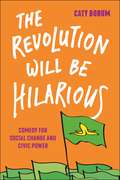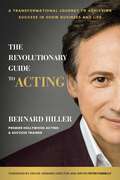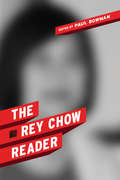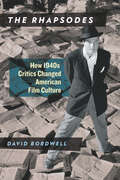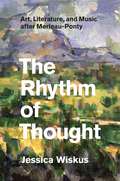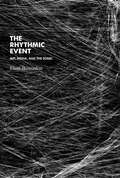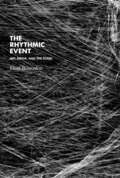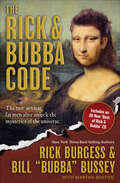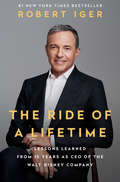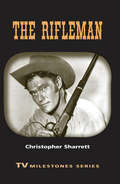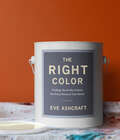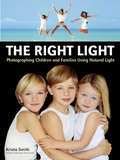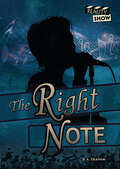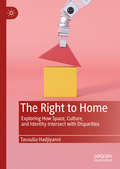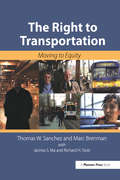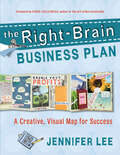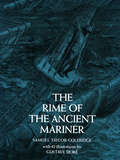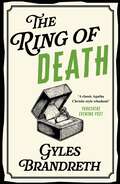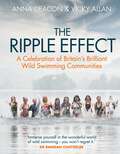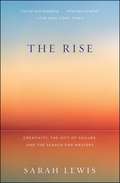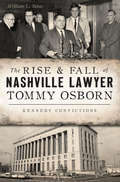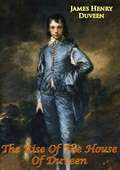- Table View
- List View
The Revolution Will Be Hilarious: Comedy for Social Change and Civic Power (Postmillennial Pop #29)
by Caty BorumAn insider’s look at the power of comedy to effect social changeFrom Trevor Noah’s The Daily Show and Hasan Minhaj’s Patriot Act, to Issa Rae’s Insecure and Corey Ryan Forrester’s Twitter feed, today’s multi-platform comedy refuses to shy away from the social issues that define our time.As more comedians lean into social justice activism, they help reshape the entertainment industry and offer creative, dynamic avenues for social change. The Revolution Will Be Hilarious offers a compelling insider’s look at how comedy and social justice activists are working together in a revolutionary media moment. Caty Borum invites readers into an expanding, enterprising arena of participatory culture and politics through in-depth interviews with comedians, social justice leaders, and Hollywood players. Their insights shed light on questions such as: What role does comedy play in helping communities engage the public with challenging social issues? How do social justice organizations and comedians co-create entertaining comedy designed to build the civic power of marginalized groups? And how are entertainment industry leaders working with social justice organizations to launch new comedy as both entertainment and inspiration for social change?Through this exploration, Borum argues that building creative power is crucial for marginalized groups to build civic power. The Revolution Will Be Hilarious positions the rise of social justice comedy as creative, disruptive storytelling that hilariously invites us to agitate the status quo and re-imagine social realities to come closer to the promise of equity and justice in America.
The Revolution in German Theatre 1900-1933 (Routledge Revivals)
by Michael PattersonFirst published in 1981, this book represents the first work in English to give a comprehensive account of the revolutionary developments in German theatre from the decline of Naturalism through the Expressionist upheaval to the political theatre of Piscator and Brecht. Early productions of Kaiser’s From Morning till Midnight and Toller’s Transfiguration are presented as examples of Expressionism. A thorough analysis of Piscator’s Hoppla, Such is Life! And Brecht’s Man show the similarities and differences in political theatre. In addition, elements of stage-craft are examined — illustrated with tabulated information, an extensive chronology, and photographs and designs of productions.
The Revolutionary Guide to Acting: A Transformational Journey to Achieving Success in Show Business and Life
by Bernard HillerBecome the actor you must be to turn your dreams into reality. For over 25 years, Bernard Hiller&’s revolutionary techniques and exercises have produced unprecedented success for actors, artists, and performers all around the world. Acting is always evolving, and in The Revolutionary Guide to Acting Bernard shares the latest methods to help you gain vital skills for success in this competitive industry. Set yourself apart at your next audition by using Bernard&’s unique techniques, and uncover the secrets to delivering unforgettable performances. Acting is a journey to self-awareness that will lead you to discover your true authenticity, empowering you to become unstoppable in show business. Cultivate the tools you will need for a long-lasting career and, ultimately, a more accomplished and happier life.
The Rey Chow Reader
by Rey ChowRey Chow is arguably one of the most prominent intellectuals working in the humanities today. Characteristically confronting both entrenched and emergent issues in the interlocking fields of literature, film and visual studies, sexuality and gender, postcolonialism, ethnicity, and cross-cultural politics, her works produce surprising connections among divergent topics at the same time as they compel us to think through the ethical and political ramifications of our academic, epistemic, and cultural practices. This anthology - the first to collect key moments in Chow's engaging thought - provides readers with an ideal introduction to some of her most forceful theoretical explorations. Organized into two sections, each of which begins with a brief statement designed to establish linkages among various discursive fields through Chow's writings, the anthology also contains an extensive Editor's Introduction, which situates Chow's work in the context of contemporary critical debates. For all those pursuing transnational cultural theory and cultural studies, this book is an essential resource.
The Rhapsodes: How 1940s Critics Changed American Film Culture
by David BordwellPauline Kael, Andrew Sarris, and Roger Ebert were three of America's most revered and widely read film critics, more famous than many of the movies they wrote about. But their remarkable contributions to the burgeoning American film criticism of the 1960s and beyond were deeply influenced by four earlier critics: Otis Ferguson, James Agee, Manny Farber, and Parker Tyler. Throughout the 1930s and '40s, Ferguson, Agee, Farber, and Tyler scrutinized what was on the screen with an intensity not previously seen in popular reviewing. Although largely ignored by the arts media of the day, they honed the sort of serious discussion of films that would be made popular decades later by Kael, Sarris, Ebert and their contemporaries. With The Rhapsodes, renowned film scholar and critic David Bordwell--an heir to both those legacies--restores to a wider audience the work of Ferguson, Agee, Farber, and Tyler, critics he calls the "Rhapsodes" for the passionate and deliberately offbeat nature of their vernacular prose. Each broke with prevailing currents in criticism in order to find new ways to talk about the popular films that contemporaries often saw at best as trivial, at worst as a betrayal of art. Ferguson saw in Hollywood an engaging, adroit mode of popular storytelling. Agee sought in cinema the lyrical epiphanies found in romantic poetry. Farber, trained as a painter, brought a pictorial intelligence to bear on film. A surrealist, Tyler treated classic Hollywood as a collective hallucination that invited both audience and critic to find moments of subversive pleasure. With his customary clarity and brio, Bordwell takes readers through the relevant cultural and critical landscape and considers the critics' writing styles, their conceptions of films, and their quarrels. He concludes by examining the profound impact of Ferguson, Agee, Farber, and Tyler on later generations of film writers. The Rhapsodes allows readers to rediscover these remarkable critics who broke with convention to capture what they found moving, artful, or disappointing in classic Hollywood cinema and explores their robust--and continuing--influence.
The Rhythm of Images: Cinema beyond Measure (Cultural Critique Books)
by Domietta TorlascoA rigorous and imaginative inquiry into rhythm&’s vital importance for film and the moving imageFocusing attention on a concept much neglected in the study of film, The Rhythm of Images opens new possibilities for thinking about expanded perception and idiosyncratic modes of being. Author Domietta Torlasco engages with both philosophy and cinema to elaborate a notion of rhythm in its pre-Socratic sense as a &“manner of flowing&”—a fugitive mode that privileges contingency and calls up the forgotten fluidity of forms. In asking what it would mean to take this rhythm as an ontological force in its own right, she creatively draws on thinkers such as Giorgio Agamben, Roland Barthes, Gilles Deleuze, and Luce Irigaray. Rhythm emerges here as a form that eludes measure, a key to redefining the relation between the aesthetic and the political, and thus a pivotal means of resistance to power.Working with constellations of films and videos by international artists—from Michelangelo Antonioni, Jean-Luc Godard, and David Lynch to Harun Farocki and Victor Burgin, among others—Torlasco brings to bear on them her distinctive concept of rhythm with respect to four interrelated domains: life, labor, memory, and medium. With innovative readings of artworks and critical texts alike, The Rhythm of Images fashions a vibrant, provocative theory of rhythm as the excess or potential of perception. Ultimately, the book reconceives the relation between rhythm and the world-making power of images. The result is a vision of cinema as a hybrid medium endowed with the capacity not only to reinvent corporeal boundaries but also to find new ways of living together.
The Rhythm of Thought: Art, Literature, and Music after Merleau-Ponty
by Jessica WiskusBetween present and past, visible and invisible, and sensation and idea, there is resonance--so philosopher Maurice Merleau-Ponty argued and so Jessica Wiskus explores in The Rhythm of Thought. Holding the poetry of Stéphane Mallarmé, the paintings of Paul Cézanne, the prose of Marcel Proust, and the music of Claude Debussy under Merleau-Ponty's phenomenological light, she offers innovative interpretations of some of these artists' masterworks, in turn articulating a new perspective on Merleau-Ponty's philosophy. More than merely recovering Merleau-Ponty's thought, Wiskus thinks according to it. First examining these artists in relation to noncoincidence--as silence in poetry, depth in painting, memory in literature, and rhythm in music--she moves through an array of their artworks toward some of Merleau-Ponty's most exciting themes: our bodily relationship to the world and the dynamic process of expression. She closes with an examination of synesthesia as an intertwining of internal and external realms and a call, finally, for philosophical inquiry as a mode of artistic expression. Structured like a piece of music itself, The Rhythm of Thought offers new contexts in which to approach art, philosophy, and the resonance between them.
The Rhythmic Event
by Eleni IkoniadouAn investigation into the affective modes of perception, temporality, and experience enabled by experimental new media sonic art.
The Rhythmic Event: Art, Media, and the Sonic (Technologies of Lived Abstraction)
by Eleni IkoniadouAn investigation into the affective modes of perception, temporality, and experience enabled by experimental new media sonic art. The sonic has come to occupy center stage in the arts and humanities. In the age of computational media, sound and its subcultures can offer more dynamic ways of accounting for bodies, movements, and events. In The Rhythmic Event, Eleni Ikoniadou explores traces and potentialities prompted by the sonic but leading to contingent and unknowable forces outside the periphery of sound. She investigates the ways in which recent digital art experiments that mostly engage with the virtual dimensions of sound suggest alternate modes of perception, temporality, and experience. Ikoniadou draws on media theory, digital art, and philosophical and technoscientific ideas to work toward the articulation of a media philosophy that rethinks the media event as abstract and affective. The Rhythmic Event seeks to define the digital media artwork as an assemblage of sensations that outlive the space, time, and bodies that constitute and experience it. Ikoniadou proposes that the notion of rhythm—detached, however, from the idea of counting and regularity—can unlock the imperceptible, aesthetic potential enveloping the artwork. She speculates that addressing the event on the level of rhythm affords us a glimpse into the nonhuman modalities of thought proper to the digital and hidden in the gaps between strict definitions (e.g., human/sonic/digital) and false dichotomies (e.g., virtual/real). Operating at the margins of perception, the rhythmic artwork summons an obscure zone of sonic thought, which considers the event according to its power to become.
The Rick & Bubba Code
by Martha Bolton Rick Burgess Bill "Bubba" BusseyDecipher the wacky worldview of the famous radio DJs (and bestselling authors) as they take on relationships, family, physical fitness, religion, and life.Zany radio hosts Rick & Bubba rocketed onto the New York Times bestseller list with their first book, Rick & Bubba’s Expert Guide to God, Country, Family, and Anything Else We Can Think Of. Now Rick & Bubba are back, and this time the world truly isn’t safe.In The Rick & Bubba Code, Rick and Bubba tackle subjects ranging from the South, politics, and romance to manhood, in-laws, and political correctness. Now cow is sacred. No hold is barred. Laugh along with the “sexiest fat men alive” as they uncover the mysteries of the universe.
The Ride of a Lifetime: Lessons Learned from 15 Years as CEO of the Walt Disney Company
by Robert IgerA grand vision defined: The CEO of Disney, one of Time’s most influential people of 2019, shares the ideas and values he embraced to reinvent one of the most beloved companies in the world and inspire the people who bring the magic to life. Robert Iger became CEO of The Walt Disney Company in 2005, during a difficult time. Competition was more intense than ever and technology was changing faster than at any time in the company’s history. His vision came down to three clear ideas: Recommit to the concept that quality matters, embrace technology instead of fighting it, and think bigger—think global—and turn Disney into a stronger brand in international markets. Twelve years later, Disney is the largest, most respected media company in the world, counting Pixar, Marvel, Lucasfilm, and 21st Century Fox among its properties. Its value is nearly five times what it was when Iger took over, and he is recognized as one of the most innovative and successful CEOs of our era.In The Ride of a Lifetime, Robert Iger shares the lessons he’s learned while running Disney and leading its 200,000 employees, and he explores the principles that are necessary for true leadership, including:• Optimism. Even in the face of difficulty, an optimistic leader will find the path toward the best possible outcome and focus on that, rather than give in to pessimism and blaming.• Courage. Leaders have to be willing to take risks and place big bets. Fear of failure destroys creativity. • Decisiveness. All decisions, no matter how difficult, can be made on a timely basis. Indecisiveness is both wasteful and destructive to morale. • Fairness. Treat people decently, with empathy, and be accessible to them. This book is about the relentless curiosity that has driven Iger for forty-five years, since the day he started as the lowliest studio grunt at ABC. It’s also about thoughtfulness and respect, and a decency-over-dollars approach that has become the bedrock of every project and partnership Iger pursues, from a deep friendship with Steve Jobs in his final years to an abiding love of the Star Wars mythology. “The ideas in this book strike me as universal” Iger writes. “Not just to the aspiring CEOs of the world, but to anyone wanting to feel less fearful, more confidently themselves, as they navigate their professional and even personal lives.”
The Rifleman
by Christopher SharrettA comprehensive analysis of what many consider to be television's most intelligent western.
The Right Color
by Eve AshcraftThe definitive guide to paint by the nation’s most sought-after color consultantWhen Martha Stewart was developing her first paint collection, the Araucana Colors (based on the hues of her chickens’ eggs), she turned to the nation’s top color consultant: Eve Ashcraft. Eve helped Martha to pinpoint the colors of that enormously successful paint line, thus assisting in transforming an industry along the way. In her first book, The Right Color, her own curated palette (her paint line launches this fall) and countless other favorite shades and color combinations provide inspiration for every room in the house. Packed with trade secrets, such as how to make a small room look bigger, how to use color to brighten a space, and how to use paint to resolve myriad architectural challenges, this book will give anyone the confidence to choose a palette that will make the most of any space.
The Right Light
by Krista SmithThe key to being a successful portrait photographer is choosing a style of photography you are passionate about. While many photographers work in multiple areas to fill the off season or offer a variety of options, most photographers focus on one style of photography. Oftentimes, the photographers' location will dictate their style. For author Krista Smith, the sunny beaches of Florida are her inspiration to shoot primarily natural light portraits, and she applies that to capturing authentic and joyful family portraits. Whether photographing entire families, kids, babies or all of the above, Smith brings an ease and comfort to the shoots that is immediately evident in her pictures. And shows you how to create the same look in your environment or clients' homes.While passion plays a key role in creating memorable portraits, employing the right techniques is essential for consistently getting those perfect shots. Smith begins by detailing what equipment you'll need to get started and gives some insight on how and what to use. She emphasizes taking the time to figure out and hone a personal style of shooting. The book lists a number of tips for finding a style that fits, including taking inspiration from other photographers you admire, and deciding what kind of feeling you want to present. Once you start to find your style it's important to build your portfolio. Organizing shoots with friends and family and offering free shoots to aspiring models is a great place to start.Outdoor shoots are the most ideal settings when using natural light as your primary light source. The author lays out the shoot requirements and gives tips for scouting the best locations. To create a photo that stands out, it's important to be versatile. While a sweeping vista covered in flowers or grand mansion may be preferred as backdrops, these are often not an option for many. A city street with multiple building textures or a small field can be used from a variety of angles to create the feel of something grander.From there the author moves onto the basics of lighting in an outdoor setting. By explaining the fundamentals of the direction and quality of light and the use of reflectors, it allows the reader to prepare for any outdoor scenario. An entire chapter of the book dedicated to shooting strategies over the course of twelve hours. There are different requirements for shooting at different times of the day. The reader will learn how to make the most of the "golden hour" and adjust for problematic midday lighting. Adapting your approach for morning, evening and sunset sessions is also covered.Sometimes weather does not cooperate for an outdoor shoot. Luckily, there are plenty of options for using natural and available light indoors. Shooting in a client's house provides a comfortable setting for the family and this ease can come across in the photos. Window light is a powerful tool to have an understanding of for these shoots. It is possible to get a variety of shots from one window. Being able to see beautiful light in all kinds of locations opens up countless shooting opportunities.While lighting is essential, thoughtful posing plays many important roles. In a well-done family portrait, the models look relaxed and natural. Some people look this way naturally, others need assistance. And posing isn't always a static thing; it can be more like orchestrating, grouping people together and getting them to move around in just the right way. It can also be used to help distract from physical problem areas, and bring added style to a photo. In addition, pointers are given on how to relax anxious children, organize families for group shots and encourage spontaneous moments.Finally, Smith discusses the business side of portrait photography. As she states in the closing chapter, there is more to the business than taking amazing photos. Without a stable financial and marketing plan it is difficult to stay competitive and possibly, stay in business. Realistic pricing packages are key. Pricing competitively is good, but it's important to consider...
The Right Light
by Krista SmithThe key to being a successful portrait photographer is choosing a style of photography you are passionate about. While many photographers work in multiple areas to fill the off season or offer a variety of options, most photographers focus on one style of photography. Oftentimes, the photographers' location will dictate their style. For author Krista Smith, the sunny beaches of Florida are her inspiration to shoot primarily natural light portraits, and she applies that to capturing authentic and joyful family portraits. Whether photographing entire families, kids, babies or all of the above, Smith brings an ease and comfort to the shoots that is immediately evident in her pictures. And shows you how to create the same look in your environment or clients' homes.While passion plays a key role in creating memorable portraits, employing the right techniques is essential for consistently getting those perfect shots. Smith begins by detailing what equipment you'll need to get started and gives some insight on how and what to use. She emphasizes taking the time to figure out and hone a personal style of shooting. The book lists a number of tips for finding a style that fits, including taking inspiration from other photographers you admire, and deciding what kind of feeling you want to present. Once you start to find your style it's important to build your portfolio. Organizing shoots with friends and family and offering free shoots to aspiring models is a great place to start.Outdoor shoots are the most ideal settings when using natural light as your primary light source. The author lays out the shoot requirements and gives tips for scouting the best locations. To create a photo that stands out, it's important to be versatile. While a sweeping vista covered in flowers or grand mansion may be preferred as backdrops, these are often not an option for many. A city street with multiple building textures or a small field can be used from a variety of angles to create the feel of something grander.From there the author moves onto the basics of lighting in an outdoor setting. By explaining the fundamentals of the direction and quality of light and the use of reflectors, it allows the reader to prepare for any outdoor scenario. An entire chapter of the book dedicated to shooting strategies over the course of twelve hours. There are different requirements for shooting at different times of the day. The reader will learn how to make the most of the "golden hour" and adjust for problematic midday lighting. Adapting your approach for morning, evening and sunset sessions is also covered.Sometimes weather does not cooperate for an outdoor shoot. Luckily, there are plenty of options for using natural and available light indoors. Shooting in a client's house provides a comfortable setting for the family and this ease can come across in the photos. Window light is a powerful tool to have an understanding of for these shoots. It is possible to get a variety of shots from one window. Being able to see beautiful light in all kinds of locations opens up countless shooting opportunities.While lighting is essential, thoughtful posing plays many important roles. In a well-done family portrait, the models look relaxed and natural. Some people look this way naturally, others need assistance. And posing isn't always a static thing; it can be more like orchestrating, grouping people together and getting them to move around in just the right way. It can also be used to help distract from physical problem areas, and bring added style to a photo. In addition, pointers are given on how to relax anxious children, organize families for group shots and encourage spontaneous moments.Finally, Smith discusses the business side of portrait photography. As she states in the closing chapter, there is more to the business than taking amazing photos. Without a stable financial and marketing plan it is difficult to stay competitive and possibly, stay in business. Realistic pricing packages are key. Pricing competitively is good, but it's important to consider...
The Right Note (Reality Show)
by D. A. GrahamEve and Ryan have been a music duo ever since they were little. Eve's voice contrasts with Ryan's creative and edgy musical style, making them a perfect pairing. They decide to audition for The Right Note, a reality music competition, hoping to get their big break. But when the show starts and they are forced to compete against each other, their relationship is tested and they begin to question their musical skills. Will either of them be strong enough musicians to compete on their own? And will they still be a duo at the end of the show?
The Right to Home: Exploring How Space, Culture, and Identity Intersect with Disparities
by Tasoulla HadjiyanniThis book explores how the design characteristics of homes can support or suppress individuals’ attempts to create meaning in their lives, which in turn, impacts well-being and delineates the production of health, income, and educational disparities within homes and communities. According to the author, the physical realities of living space—such as how kitchen layouts restrict cooking and the size of social areas limits gatherings with friends, or how dining tables can shape aspirations—have a salient connection to the beliefs, culture, and happiness of the individuals in the space. The book’s purpose is to examine the human capacity to create meaning and to rally home mediators (scholars, educators, design practitioners, policy makes, and advocates) to work toward Culturally Enriched Communities in which everyone can thrive. The volume includes stories from Hmong, Somali, Mexican, Ojibwe, and African American individuals living in Minnesota to show how space intersects with race, gender, citizenship, ability, religion, and ethnicity, positing that social inequalities are partially spatially constructed and are, therefore, malleable.
The Right to Transportation: Moving to Equity
by Thomas SanchezDoes transportation affect the lives of minority, low-income, elderly, and physically disabled citizens? The answer is yes, and those effects can be profound, according to The Right to Transportation. The authors argue that transportation policies can limit access to education, jobs, and services for some individuals while undermining the economy and social cohesion of entire communities. Policies that have nurtured the U.S. highway system and let public transportation wither have also led to ghettos and social isolation. More and more communities are recognizing the problem. This book explains the strategies and policies that can address inequities in the nation's transportation and transportation planning systems so that the benefits and burdens of those systems can be shared equally across all communities. With a close examination of how transportation policies affect individuals and communities, the book is a guide to transportation fairness. It explains the demographic trends, historical events, and current policies that have shaped transportation in the U.S. and offers recommendations for moving to equity.
The Right-Brain Business Plan: A Creative, Visual Map for Success
by Jennifer LeeMillions of artists, entrepreneurs, crafters, and solopreneurs dream of making a living doing what they love. But turning their vision into a viable business plan can feel like trying to fit a square peg into a round hole. Jennifer Lee knows what it’s like to make the entrepreneurial leap — and how to do it successfully. The key is showing creative types how to use — rather than stifle — the imagination and intuition that make them creative in the first place. Lee’s illustrated, colorful worksheets and step-by-step instructions are playful yet practical, enabling readers to get down to the essential business of defining their vision and nailing down plans for funding, marketing, networking, and long-term strategy. Both budding and seasoned business owners will benefit from Lee’s wonderfully original approach. Discover how to: • Develop a financial plan with fun and flair • Select your circle of support to get the work done • Clarify your business values and goals • Paint a picture of your business landscape • Understand your competition and what makes you stand out from the crowd • Identify your perfect customers and create a marketing plan to reach them • Map out concrete action steps to bring your Right-Brain Business Plan to life
The Rime of the Ancient Mariner
by Gustave Doré S. T. ColeridgeGustave Dore's magnificent engravings for The Rime of the Ancient Mariner are among the later works of the great French illustrator. The intensely evocative poem provided Doré with the long-awaited opportunity to convey limitless space on a gigantic scale, and he exploited the poem's fantastic range of atmosphere to the limits of its possibilities. The terrifying space of the open sea, the storms and whirlpools of an unknown ocean, the vast icy caverns of Antarctica, the hot equatorial sea swarming with monsters, all of the amazing visual elements that make Coleridge's masterpiece one of the most exciting and most memorable poems in the English language are unforgettably engraved in Doré's plates.This edition reproduces all of the plates to perfection, in their original size. The illustrations and the text of the poem appear on facing pages, so that the imaginative kinship of Doré and Coleridge is delightfully evident on every page: the illustrations capture all the moods of the poem in their full intensity, bringing the images evoked by the words into clear visual focus. Unabridged and slightly rearranged republication of the 1878 American edition. Text slightly amended to conform to the authoritative 1834 edition of the poem.
The Ring of Death: The Victorian Murder Mystery Series: 2 (The Victorian Murder Mystery Series #2)
by Gyles Brandreth'So amazingly good, I could not put it down' Reader review ⭐⭐⭐⭐⭐'An inventive and highly enjoyable murder mystery' Reader review ⭐⭐⭐⭐⭐Will a game of Murder at a dinner party turn deadly?London 1892: Author Oscar Wilde has assembled friends and acquaintances for one of his Sunday Supper Clubs, among their number is his great friend and creator of Sherlock Holmes, Arthur Conan Doyle. Mid-way through the evening, a game is proposed: each guest must write down the name of the person they would most like to kill.But soon, the fictional victims begin to die one-by-one in mysterious circumstances - in the order their names were drawn during the game.With growing horror, Wilde and Doyle realise that one of their guests must be the murderer. Trapped in a race against time, they must uncover the killer's identity before they can complete their final move . . .A wonderfully witty and addictive cosy historical mystery that presents the reader with an intricate puzzle to solve. Perfect for fans of Sherlock Holmes, Agatha Christie and Richard Osman.Readers are gripped by The Ring of Death:'Crackles with wit, tension, mysteries, and is reminiscent (but dare I say better) than the Sherlock Holmes canon' Reader review ⭐⭐⭐⭐⭐'Oscar Wilde is solving crimes while rubbing elbows with Sir Arthur Conan Doyle . . . What's not to like?' Reader review ⭐⭐⭐⭐⭐'This book had everything I love in a story: historical detail, cleverness, wonderful conversational by-play . . . BRAVO!' Reader review ⭐⭐⭐⭐⭐
The Ripple Effect: A Celebration of Britain's Brilliant Wild Swimming Communities
by Anna Deacon Vicky AllanA Beautifully Photographed Swimming Book“Immerse yourself in the wonderful world of wild swimming - you won't regret it.” -Dr. Rangan ChatterjeeDive into the wonderful world of wild swimming with a series of photographs by Anna Deacon that captures the wonderful world of diving.Forging friendships in the water. Enter the world of aquatics and learn about the community of swimmers that Britain’s wild swimming creates. Wild swimming isn’t just a pastime; it’s an ocean of connection that attracts swimmers across Britain and draws people from all walks of life to dive deep and find inspiration in the water.A swimmer’s paradise. The Ripple Effect showcases all types of swimmers. From fans of the wim hof method to those who want to take their swimming exercises to the open water, this book of aquatic photography is the perfect gift for swimmers.More than just pictures. Anna Deacon offers a community to connect. With visually stunning photographs depicting wild swimmers in Britain’s natural aquatic habitats, you’ll feel just as eager to go diving for your own wild adventure.Inside, you’ll find: Authentic photography showcasing an array of wild swimming communitiesSwimming stories that inspire, encourage, and laughThe wonderful world of wild swimming and why it’s so popular in BritainIf you liked Shaping Surf History, Comp, or Women Making Waves, or Winter Swimming, you’ll love The Ripple Effect.
The Rise
by Sarah LewisIt is one of the enduring enigmas of the human experience: many of our most iconic, creative endeavors--from Nobel Prize-winning discoveries to entrepreneurial inventions and works in the arts--are not achievements but conversions, corrections after failed attempts. The gift of failure is a riddle. Like the number zero, it will always be both a void and the start of infinite possibility. The Rise--a soulful celebration of the determination and courage of the human spirit--makes the case that many of our greatest triumphs come from understanding the importance of this mystery. This exquisite biography of an idea is about the improbable foundations of creative human endeavor. The Rise begins with narratives about figures past and present who range from writers to entrepreneurs; Frederick Douglass, Samuel F. B. Morse, and J. K. Rowling, for example, feature alongside choreographer Paul Taylor, Nobel Prize-winning physicists Andre Geim and Konstantin Novoselov, Arctic explorer Ben Saunders, and psychology professor Angela Duckworth. The Rise explores the inestimable value of often ignored ideas--the power of surrender for fortitude, the criticality of play for innovation, the propulsion of the near win on the road to mastery, and the importance of grit and creative practice. From an uncommonly insightful writer, The Rise is a true masterwork.
The Rise & Fall of Nashville Lawyer Tommy Osborn: Kennedy Convictions (True Crime)
by William L. TabacTommy Osborn's star was rising. The young Nashville lawyer led a band of Tennessee reformers to victory in a landmark Supreme Court case. Hailed by Chief Justice Earl Warren as the most important of his career, Baker v. Carr's "one man, one vote" mandate revolutionized how Americans chose their representatives. Osborn was hired by Jimmy Hoffa to take on Bobby Kennedy for the fourth time. Unfortunately, the young lawyer met his match in Walter Sheridan, Kennedy's top aide and brilliant spymaster. Author William L. Tabac describes the extraordinary legal proceeding with the twists and turns of a modern television drama and the fall of a prominent attorney.
The Rise Of The House Of Duveen
by James Henry DuveenThis book provides an exciting portrayal of the history of the Duveen family in the art business up to 1939."THOUGH MANY REASONS have contributed to impel me to write this hook, the chief one is the memory of my uncle Joel Joseph Duveen. On the death of my father at the untimely age of twenty-nine, when I was four years old, my uncle was appointed my guardian by the Dutch court. He took a constant interest in me as I grew up; and, seeing how much I admired his energy and brilliance, he loved to tell me his interesting experiences. I was an eager listener and made notes of all he told me. He frequently invited me to accompany him on long journeys, and I spent many holidays with him on the Continent; the most pleasurable and exciting parts of these travels with him were the stories of his early life and the reminiscences of his business career."A friend [...] sent me in 1954 a fascinating book, Duveen, by S. N. Behrman, a gifted American author, which I read with the greatest interest. In it he has produced a brilliant picture of Lord Duveen's character and methods, and he is to be congratulated on his successful portrait. But this exciting book is chiefly concerned with the period of Lord Duveen; and I am grateful to its author for inspiring me to take up my pen again and place on record the greatness of the older generation who, by more brilliant but less grandiose methods, created the firm Lord Duveen raised to a height that may never again be equalled."I therefore began [...] to set down my memories of a line of great and intrepid connoisseurs in art. In our careers the art treasures in which we dealt and the great figures who formed our clientele are more interesting than we are ourselves. For this reason I have tried to picture the characters of my family by their adventurous dealings rather than by long biographical sketches; the incidents related are authentic in all details except names, some of which have been disguised for obvious reasons."
